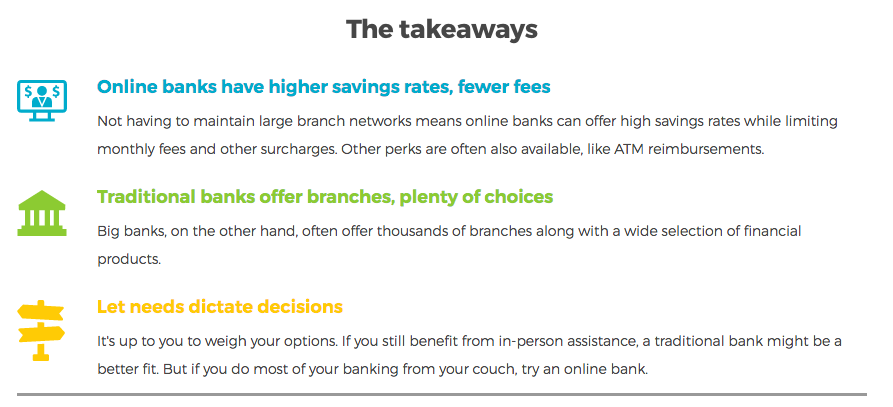In 1960, Life magazine described a new Wells Fargo branch in San Francisco as having “such striking architecture that it is now a local tourist attraction.” It was one of many “glass-and-metal palaces” that transformed the public’s perception of banks “from solemn financial cathedral into joyous playroom,” complete with 4% interest rates and prizes for new customers.
Fast-forward half a century, and a different kind of banking evolution is underway. Traditional brick-and-mortar institutions face increasing competition from online-only banks that offer checking and savings accounts with fewer fees and higher rates. Of the 11% of people who switched banks in 2015, 19% of them joined an online bank while only 8% left one, according to consulting firm Accenture.
One of the most prominent online-only banks, Ally, signed its one millionth account holder in 2015, and reported that it added another 150,000 customers in 2016.
Many people still prefer traditional banks, but the continued growth of online banking has made one thing clear: That branch down the street is no longer the only place to keep your checking and savings accounts.
Different banks, different strengths
Online banks’ checking and savings accounts come with higher interest rates and fewer fees than those at traditional banks. Rates at top online banks can be as high as 1.20%, 20 times the national average of 0.06%.
Average rates at credit unions aren’t much better, according to data from the National Credit Union Administration.
Online banks also tend to offer more perks on their standard checking accounts. One example: unlimited domestic ATM fee reimbursements. Traditional banks occasionally offer the same, but often only on premier checking accounts that require steep minimum deposits — think $10,000 and up — to get monthly fees waived. These fees can be as high as $25 per month.
And digital banks are more likely to offer rewards on basic accounts, such as cash back.
Banking behemoths, meanwhile, have their own strengths. Their branches, often numbering in the thousands, provide in-person support, which consumers still seek. Nearly nine in 10 people plan on using their bank branches in the future, according to the Accenture survey, which isn’t possible with an online-only bank.
What’s more, big banks have had decades to establish relationships with their customers, which has bred trust, says Rob Morgan, vice president of emerging technologies at the American Bankers Association. That’s something he thinks many financial technology companies haven’t quite been able to do yet.
And while online banks generally focus on checking and savings accounts, big banks offer financial products including credit cards, mortgages and other loans. But maintaining this infrastructure is expensive, so large banks typically charge fees and pay low interest rates on deposit accounts. This makes it difficult to provide the type of consumer-friendly checking and savings accounts that online banks do.
“Big banks are far-flung, trillion-dollar enterprises that are as focused, if not more so, on their commodities trading desk as they are on what the consumer banking experience looks like,” says Chris Britt, CEO and co-founder of Chime, an online bank that doesn’t charge overdraft fees. Online banks often keep this type of fee low.
» MORE: New changes, new options in banking
Traditional banks and online offshoots
But online banks are often connected with larger institutions. This enables them to offer certain benefits, including the same government-backed protections that brick-and-mortars provide, only with better deposit accounts.
Bank5 Connect, for instance, is an online subsidiary of the regional brick-and-mortar, BankFive, which serves Massachusetts and parts of Rhode Island. Because Bank5 Connect is a division of BankFive, it provides Federal Deposit Insurance Corp. insurance.
This coverage, which is offered by most banks, kicks in in the event of a bank failure and protects up to $250,000 of a person’s funds, per bank and per account type. Unlike traditional institutions, though, Bank5 Connect charges fewer fees and pays higher APYs.
Online bank Simple, meanwhile, works with the brick-and-mortar BBVA Compass, and Ally Bank belongs to the financial holding company Ally Financial Inc., one of the largest of its kind in the country.
Although most of the biggest U.S. banks are putting increasing emphasis on mobile banking, many have yet to create an online offshoot.
“Creating a separate online-only bank requires a significant investment of time, energy and money,” says Deirdre Jannerelli, digital marketing manager at BankFive.
Apply pressure, weigh options
So how can you ensure you’re getting the best banking services possible? Consider why you chose your bank. If you’re with the institution purely out of inertia, it might be time to explore your alternatives, including online banks.
And even if you’re sticking to a brick-and-mortar because of the in-person assistance it affords, you can still let your bank know the features you’d like to see.
“Banks get certain signals,” says Phil Ryan, senior editor at Bank Innovation, a website that covers developments in financial technology. “If you switch direct deposit away from a bank, or if you stop using its ATM card, that bank should be able to understand that this relationship is dipping, and that maybe it should be doing something about that.”
But consumers aren’t providing those kinds of signs in significant enough numbers to encourage banks to improve their services. That’s partially because people may not know that lower fees and better rates are available, Ryan says.
It’s too soon to talk about the takeover of online banks, but it’s clear that people are willing to switch. And while it may take some time before you consider any bank a “joyous playroom,” resigning yourself to steep fees and low rates is no longer your only option.
Tony Armstrong is a staff writer at NerdWallet, a personal finance website. Email: tony@nerdwallet.com. Twitter: @tonystrongarm.
The article Online Banks Give Consumers More Options originally appeared on NerdWallet.



